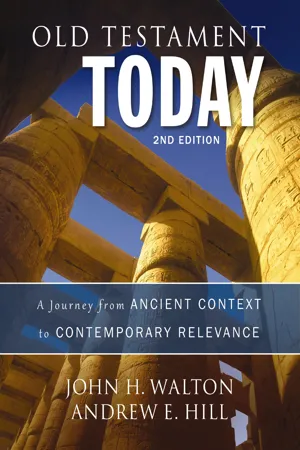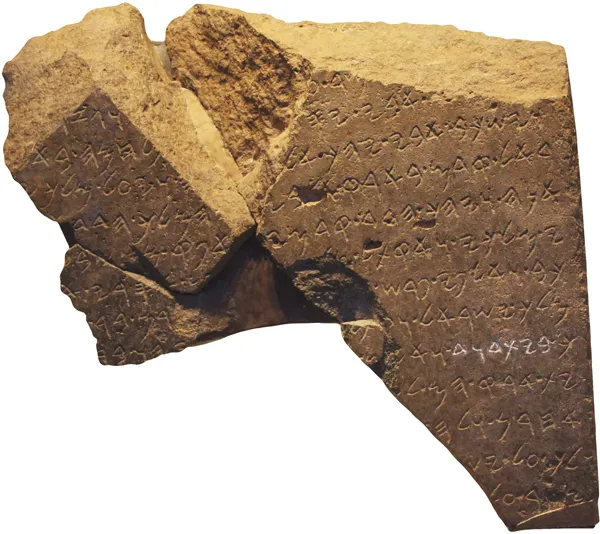1
ORIENTATION FUNDAMENTALS
ABOUT THE OLD TESTAMENT
The Old Testament can be considered a book, a part of a book, and a collection of books. It is a book to the extent that its parts form a single whole. This book is often referred to today as the Hebrew Bible since it constitutes the Scripture of the Jewish people. As history progressed and Jesus Christ came, taught, died, and rose again, a whole new round of Scripture was formed to document the life of Christ and the rise of the church and to explore the theological and practical implications of what Christ had done. This New Testament was joined with the Old to become the Christian Bible, and so the Old Testament has become part of that book.
We also understand that the Old Testament is a collection of books—thirty-nine books by various authors written over the span of a millennium. These books share a common religious perspective, but they vary widely in the types of literature they represent and the functions they serve. In the pages of these books, the reader will find consideration of origins, tribal and national histories, collections of laws, collections of poetry, philosophical discussions, and prophetic sermons. But in all of these and through all of these, the reader will find theology—or, more appropriately put, God. Although the genres (types of literature) may vary, each is theological throughout. So, for instance, the discussion of origins is not about science, it is about God. The presentation of history is not concerned with facts or events in themselves; it is concerned with God’s role. And perhaps most important, rather than simply being thoughts and opinions about God, the Old Testament is God’s presentation of himself: his self-revelation.
The Old Testament can be considered a book, a part of a book, and a collection of books.
THE BIG STORY LINE/PLOTLINE
God made the world operational and put people into it. Adam and Eve disobeyed his command, resulting in their being driven from the Garden of Eden and thus losing access to sacred space. Thus begins the story of dislocation. Over time the “Eden problem,” sin, became so pervasive that God sent the flood to destroy all but Noah and his family. The Tower of Babel represents the next step, as people imagined that God had needs and saw themselves as providing the way for God to come down and have his needs met. This misperception of God can be called the “Babel problem.”
Consequently, God chose Abraham to be the ancestor of a chosen people through whom he would reveal himself and correct the distortion represented at Babel. He brought Abraham to the land of Canaan, where his family lived on the brink of extinction for three generations before going down to Egypt. There they lived for more than four hundred years and became a large nation. God brought them out of great oppression in Egypt, and they began their journey back to the land of Canaan, the Promised Land. After stopping at Mount Sinai, where Moses received the law—God’s next phase in revealing himself—they were waylaid in the wilderness for a generation because they lacked the faith to let God lead them into the land.
Sequence
Creation
Fall
Flood
Tower of Babel
Patriarchs
Sojourn
Exodus
Wilderness
Conquest
Judges
United Kingdom
Divided Kingdom
Exile
Return
Under the command of Joshua, the Israelites returned to the land and, in a series of battles, God won them control of the land. Joshua divided the land among the tribes, and they began to settle in. Over the next several centuries, known as the period of the judges, there was no king. Each tribe had its own tribal leadership, but they constantly fell prey to the surrounding nations. God allowed this because of the failure of the Israelites to be faithful to God in their beliefs.
Finally, the people initiated a move to a monarchic form of government. The first attempt, in which Saul was crowned king, failed because of unrealistic and theologically misguided expectations of the king and his role. At Saul’s death, Israel was just as bad off politically and spiritually as when he came to the throne. The second attempt was more successful. David was chosen by the Lord to be king, his dynasty became established through a covenant with the Lord, and Jerusalem was made the capital city. As the empire of David expanded, Israel finally came into control of the land that had been promised to Abraham nearly a millennium earlier. He successfully passed this empire to his son Solomon, but Solomon’s misjudgments and excesses in both political and theological terms eroded the empire as well as the support of the people. After Solomon’s death in 931 BC, his son Rehoboam retained control of only a small section of the kingdom from Jerusalem south, while God gave a new dynasty control of the much larger northern kingdom. The southern kingdom was now designated “Judah” and the northern kingdom, under Jeroboam, was designated Israel.
For just over two hundred years, this situation continued. The Davidic dynasty remained in control in Judah, while the northern kingdom, Israel, experienced a series of dynastic lines. When the Assyrians extended their control across the ancient world in the middle of the eighth century, Israel joined a coalition against the Assyrians and eventually lost the war. The capital city, Samaria, was destroyed in 722 BC, and the northern kingdom was assimilated into the Assyrian Empire. Judah remained an independent nation but was for the most part under Assyrian control. During this time there were kings who were faithful to the Lord (such as Hezekiah), but for the middle fifty-five years, Manasseh forged a regime that accepted not only Assyrian rule, but foreign religious practice as well. The Assyrian Empire lasted for another century until it weakened and was taken over by the Medes and the Babylonians.
Already as the Assyrian Empire receded, the prophetic voices in Judah, such as Jeremiah, were calling on the people to return to the Lord and were warning of impending doom at the hands of the Babylonians. The Assyrian Empire breathed its last gasp in the fall of Carchemish in 605 BC and the Babylonians began to exert their control into Judah. For several years it is uncertain whether Babylon or Egypt would have the greatest influence, and the kings of Judah rock back and forth. Eventually Babylon prevailed as the army under Nebuchadnezzar moved west to punish the rebellious King Jehoiakim. His son Jehoiachin was taken into exile in Babylon along with many others in the administration, but the kingdom was left intact. In the next decade, however, the lure of rebellion became too strong, and King Zedekiah joined a conspiracy against the Babylonians. This time there was no mercy. The result of the Babylonian invasion in 587 was the destruction of Jerusalem and its temple, the massive deportation of the Israelites, and the incorporation of Judah as a Babylonian province. The prophets’ warnings had come to pass, and for the first time in over four hundred years, there was no king on David’s throne.
The seventy years spent in exile are given very little treatment in the text. Prophetic voices such as Ezekiel and Daniel continued to speak, but no historical literature discusses the situation in either Israel or Babylon. When the Babylonian Empire falls to the Persian king Cyrus in 539 BC, a new policy of tolerance allowed the exiles to return to Israel and rebuild their temple. In this postexilic period, they had no king, but a governor ruled the small state of Yehud on behalf of the Persian king. Under the leadership of individuals such as Ezra and Nehemiah, the city of Jerusalem was rebuilt and the people recommitted themselves to the covenant and the Lord. Yet they remained a state under Persian rule until Alexander the Great overthrew the Persians and they become part of another empire. As Daniel had indicated, empire followed empire as the people waited for their deliverance and the return of a Davidic king, their Messiah.
REORIENTATION: OLD TESTAMENT AS REVELATION, SCRIPTURE, AND AUTHORITY
If it is true that the Bible is God’s self-revelation, we must move beyond the superficial levels of description in the previous paragraphs. It is not enough to say “The Old Testament is a collection of thirty-nine books written in Hebrew (and Aramaic) that became the Scriptures of the Jewish people as well as Christians,” although this certainly is true. But that is what the Old Testament is—we need to be reoriented to what the Old Testament does.
It is not enough to know what the Old Testament is; we need to reorient to what it does.
Revelation
When we say that the Old Testament is God’s revelation of himself, we are affirming that in the Old Testament God is telling us his story. So begins our quest in the Bible. We need to know God, and the Bible is his story. When we first come to know someone, we become acquainted by relating parts of our stories to one another. The first pages we open include our name, our hometown, and other basic information. As acquaintances become friends, they unfold more and more of their storie...



